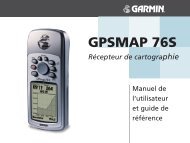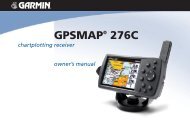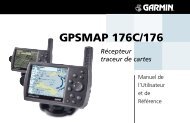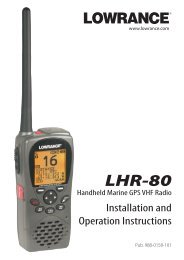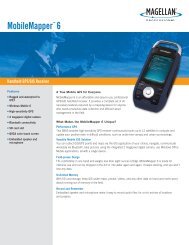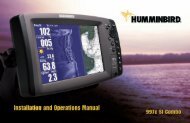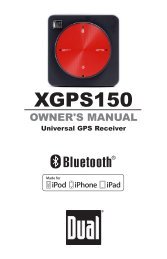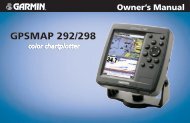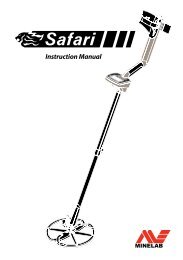X515C DF & X510C Manual - Lowrance
X515C DF & X510C Manual - Lowrance
X515C DF & X510C Manual - Lowrance
Create successful ePaper yourself
Turn your PDF publications into a flip-book with our unique Google optimized e-Paper software.
Section 6:<br />
Sonar Troubleshooting<br />
If your unit is not working, or if you need technical help, please use the<br />
following troubleshooting section before contacting the factory customer<br />
service department. It may save you the trouble of returning<br />
your unit for repair. For contact information, refer to the last page, just<br />
inside the back cover of this manual.<br />
Unit won't turn on<br />
1. Check the power cable's connection at the unit. Also check the wiring.<br />
2. Make sure the power cable is wired properly. The red wire connects<br />
to the positive battery terminal, black to negative or ground.<br />
3. Check the fuse.<br />
4. Measure the battery voltage at the unit's power connector. It should<br />
be at least 10 volts. If it isn't, the wiring to the unit is defective, the<br />
battery terminals or wiring on the terminals are corroded, or the battery<br />
needs charging.<br />
Unit freezes, locks up, or operates erratically<br />
1. Electrical noise from the boat's motor, trolling motor, or an accessory<br />
may be interfering with the sonar unit. Rerouting the power and transducer<br />
cables away from other electrical wiring on the boat may help.<br />
Route the sonar unit's power cable directly to the battery instead of<br />
through a fuse block or ignition switch<br />
2. Inspect the transducer cable for breaks, cuts, or pinched wires.<br />
3. Check the transducer and power connector. Make sure it's securely<br />
plugged in to the unit.<br />
Weak bottom echo, digital readings erratic, or no fish signals<br />
1. Make sure the transducer is pointing straight down. Clean the face of<br />
the transducer. Oil, dirt and fuel can cause a film to form on the transducer,<br />
reducing its effectiveness. If the transducer is mounted inside the<br />
hull, be sure it is shooting through only one layer of fiberglass and that it<br />
is securely bonded to the hull. When attaching a transducer to the inside<br />
of a hull, ONLY use the epoxy available from LEI (order information is<br />
inside the back cover). Do NOT use RTV silicone rubber adhesive or any<br />
other type of epoxy. The LEI epoxy is specially formulated so that it will<br />
cure properly for shoot-through applications.<br />
113



